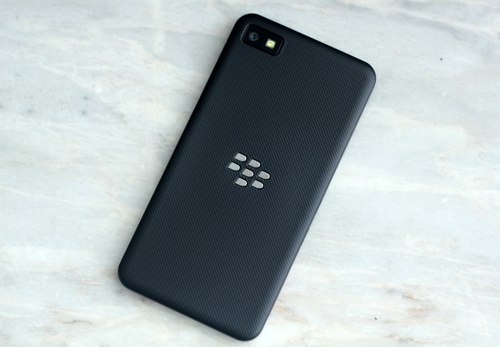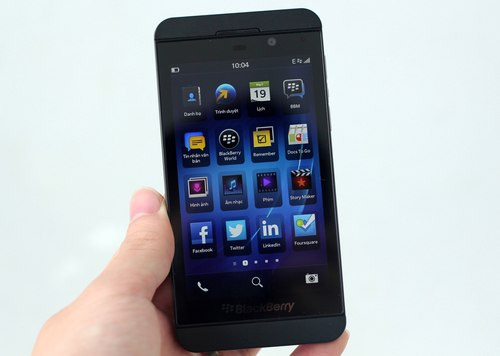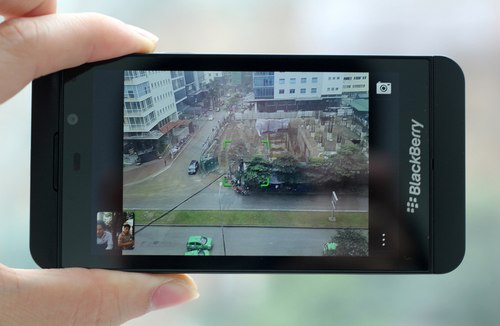Being a good smartphone
in many aspects, it should prove to be fun to BlackBerry loyalists but at the price
of $679, the Z10 is not a reasonable and attractive product for most consumers.
The Z10 possesses many more new features
rather than inherited or improved those of other previous BlackBerry phones.
Launched in an event that all technology world paid attention to in late
January 2013, the Z10 is the product that expresses Blackberry’s determination
to return to the top rank in the phone market.
The appearance of the Z10 also shows RIM’s new
name, which has been changed to the new BlackBerry brand, and focuses on smartphones
with touchscreen instead of the traditional QWERTY keyboard.
Design
The traditional traits in BlackBerry’s design
no longer appear on the Z10. Even on BlackBerry’s previous predecessors with
touchscreen such as Storm or Torch, there are no common features shared between
the two products. Even if there were any, the Z10 would somehow remind people of
the BlackBerry PlayBook tablet.

The
Z10 is a bar-like smartphone with touchscreen, no longer carrying the traits of
BlackBerry’s other traditional phones with QWERTY keyboard.
With the red and white versions, the Z10 is
a beautifully designed smartphone although it does not follow today’s trend of
unibody design. Instead, the chassis is made in the same old-style way, dividing
the body into layers, with the back cover that can be removed to replace the
battery, memory card or SIM.
BlackBerry does not use the aluminum
material or Polycarbonate but instead uses the usual plastic casing for the
Z10. So, this touch-screen smartphone has a fairly light weight, only 137.5
grams. But with thick left and right screen borders, it looks quite big
(130x65.6x9 mm), similar to other Android phones with the screen size of 4.5 to
4.8 inches despite their size of only 4.2 inches.
The Z10’s front face shows a unique trait with
a BlackBerry logo with a metallic color that shines on the glossy glass surface
in the center, which occupies most of the front. The top and bottom edges are
made of rough plastic in order to create accents, but they are quite thick.
Interestingly, the machine does not use any knid of buttons on the front,
including those touch keys. However, all operations must be made on the Z10 are
very handy thanks to intelligent control capabilities of the BB10 operating
system.

A
silver bunch of strawberries is the most remarkable trait on the Z10’s back.
The back of the Z10 is designed with dotted
veins, but they are not really rough and do not cling firmly to the hand due to
the use of plastic materials. The camera cluster is simply designed and its location
slightly sinks to the bottom of the back cover. If compared to the previous generation
of BlackBerry phones, the back of the Z10 is simpler and not as attractive.
Unlike the plain front and back sides, the
border around the machine was designed with lots of connectors. The left side has
two ports located adjacent to each other and are not covered, which looks king
of tough, including microUSB and miniHDMI porta. This arrangement makes the use
of the Z10 a little uncomfortable and annoying when charging the machine,.
On the opposite side is a series of volume
up and down buttons made of metal, and in the middle is the key to pause the
music player. Blackbery placed the power key in the center and if using it with
one hand, users will often have to reach out the hand to manipulate things on
the screen. However, owning the unlock feature without having to press the hard
button on the Z10 does not cause this power key to be a big problem.
Overall, the BlackBerry 10 is a smartphone that
has a beautiful design, giving a good feel of using touch quite comfortably
with light weight and the size that can fit one hand.
Display
BlackBerry phones always have good
appreciation of the display, so the Z10 also owns a pretty nice screen. When
introduced, the CEO of BlackBerry was confident that their touch model had an
excellent screen with the latest display technology.

The
Z10’s screen is nice and sharp.
In fact, its resolution is a little bit
bigger than the standard HD (1,280x768 pixels) 4.2-inch screen, which gives it
a high pixel-density of 355 ppi. Combined with fonts and symbols beautifully
modified, the screen is very sharp and smooth. Instead of using the Super
AMOLED screen as on the Q10, the Z10 uses an LCD screen, so colors are not too
bright and gives a neutral feel. If compared with the current outstanding smartphones
with a 5-inch Full HD screen, this BlackBerry’s screen proves to be competitive
in many aspects.
Another advantage is that the Z10’s screen has
high contrast, deep blacks and provides clear display even in outdoor situations,
under sunlight and offering wide viewing angles. However, its disadvantage is
that the screen’s easy to get fingerprint stains, which makes the phone become
quite dirty after using and always need to be cleaned.
Camera
Like many of today's smartphones, the touch
BlackBerry 10 owns two cameras in the front and back. In particular, the main
camera has the resolution of 8 megapixels, with Full HD 1080p video recording support
that comes with a Flash LED while the second camera for video calling has the
resolution of 2 megapixels with HD video recording support.

The
camera interface on the Z10
The cameras offer a surprising and
interesting experience to Z10 loyalists. First of all, it is the interface, for
which BlackBerry follows the trend of simplicity with few buttons as iOS and
Windows Phone has done before. Users can click on the screen to capture as they
do on the iPhone. The installation process when shooting photos or recording videos
have been greatly reduced, now it only allows selection of resolution, or frame
rate mode ... and does not have any settings to choose as on Android.
Secondly, the Z10 has one of the best
cameras in the smartphone series now, especially in conditions with much light.
The advantage is high detail and sharpness even with a large zoom-in, and the
color of the photos is also quite honest. Besides, the shutter speed is also an
interesting feature; the camera focuses and shoots almost immediately after
touching the screen, and even when you turn on flash, the shutter speed is
still faster than those on most of other current high-end phones.
TimeShift is an interesting and useful
feature on the Z10, which BlackBerry acquired from Scalado. On Samsung Galaxy S
III or Note II there is the same feature, but the use and quality of TimeShift
on the Z10 is different and even better.
This feature helps optimize self-portraits
or group-shooting. The camera automatically shoots continuous photos, then
automatically detects the faces in the photo. So, after taking photos, the user
can select any face and moment they want. TimeShift's ability to handle photos
on the Z10 is so impressive, offering the best quality to the final result.

The
photo editing tool on the Z10 has plenty of functions.
Like still photos, videos which are
recorded by the main camera provide good image quality, although the sound is
fairly acceptable. Though capturing and recording videos on the Z20 is much
simplified, video and photo editing tools on the Z10 are quite powerful,
supporting multiple color effects as well as some other settings.